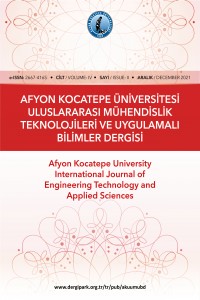Abstract
Hayatta radyasyona maruz kalmanın birçok yolu vardır. Özellikle tıbbi uygulamalar, şiddetli maruziyetin en önemli sebebidir. Tıbbi uygulamalarda Bilgisayarlı Tomografi (BT) taramaları ilk sırada yer alırken, nükleer tıp ikinci sırada yer almaktadır. Tabii ki, maruz kalan doku ve dolayısıyla organlar tarafından emilen doz, sağlığa yönelik risklerle doğru orantılıdır. Nükleer tıpta tedavi amaçlı vücuda yerleştirilen radyoizotoplar nedeniyle sadece tümörün bulunduğu organ ve/veya dokulara değil, çevredeki diğer organ ve dokular az miktarda olsa da doz absorbe eder. Bu çalışmada erişkin fantomların (erkek ve dişi) tiroid bezine yerleştirilen iyot radyoizotop I-131'in aktivitelerine göre tiroid bezi, timüs ve lenf bezlerinin aldığı dozlardaki değişim Monte Carlo-tabanlı NCINM kodu ile araştırılmıştır.
Keywords
References
- Andreo, P., 1991. Monte Carlo techniques in medical radiation physics, Phys Med Biol, 36, 861-920.
- Caon, M., 2004. Voxel-based computational models of real human anatomy: a review, Radiat Environ Biophys, 42, 229–35.
- Cristy, M., 1980. Mathematical Phantoms Representing Children of Various Ages for use in Estimates of Internal Dose, Oak Ridge, Oak Ridge National Laboratory.
- Ding, A., Mille, M.M., Liu, T., Caracappa, P.F. and Xu, X.G., 2012. Extension of RPI-adult male and female computational phantoms to obese patients and a Monte Carlo study of the effect on CT imaging dose, Phys Med Biol, 57, 2441–59.
- Geyer, A.M., O’Reilly, S., Lee, C., Long, D.J. and Bolch, W.E., 2014. The UF/NCI family of hybrid computational phantoms representing the current US population of male and female children, adolescents, and adults—application to CT dosimetry, Phys Med Biol, 59, 5225–42.
- ICRP, 1991. 1990 recommendations of the International Commission on Radiological Protection, ICRP Publ. 60, Ann. ICRP 21, 1–201.
- ICRP, 2007. The 2007 recommendations of the International Commission on Radiological Protection ICRP Publ. 103, Ann. ICRP 37, 1–332.
- ICRP, 2008. Nuclear Decay Data for Dosimetric Calculations, ICRP Publ. 107, Ann. ICRP 38-3, 1-123.
- Loevinger, R., Budinger, T.F., Thomas, F. and Watson, E.E., 1991. MIRD Primer for Absorbed Dose Calculations revised edition, New York: Society of Nuclear Medicine.
- Toohey, R.E., Stabin, M.G. and Watson, E.E., 2000. Internal Radiation Dosimetry: Principles and Applications. The AAPM/RSNA Physics Tutorial for Residents, 20, 533-546.
- Xu, X.G., 2014. An exponential growth of computational phantom research in radiation protection, imaging, and radiotherapy: a review of the fifty-year history, Phys Med Biol, 59, R233–302.
Abstract
There are many ways to be exposed to radiation in life. Medical applications, in particular, are the most important form of severe exposure. In medical applications, Computed Tomography (CT) scans are in the first place, while nuclear medicine is in the second place. Of course, the dose absorbed by the exposed tissue and therefore the organs is directly proportional to the risks to health. In nuclear medicine, due to the radioisotopes placed in the body for therapeutic purposes, some doses are not given only to the organ and/or tissues where the tumor is placed, but also to other surrounding organ and tissues. In this study, the change in the doses received by the thyroid gland, thymus, and lymph nodes according to the activities of the iodine radioisotope I-131 placed in the thyroid gland of adult phantoms (both male and female) were investigated with the Monte Carlo-based code.
Keywords
References
- Andreo, P., 1991. Monte Carlo techniques in medical radiation physics, Phys Med Biol, 36, 861-920.
- Caon, M., 2004. Voxel-based computational models of real human anatomy: a review, Radiat Environ Biophys, 42, 229–35.
- Cristy, M., 1980. Mathematical Phantoms Representing Children of Various Ages for use in Estimates of Internal Dose, Oak Ridge, Oak Ridge National Laboratory.
- Ding, A., Mille, M.M., Liu, T., Caracappa, P.F. and Xu, X.G., 2012. Extension of RPI-adult male and female computational phantoms to obese patients and a Monte Carlo study of the effect on CT imaging dose, Phys Med Biol, 57, 2441–59.
- Geyer, A.M., O’Reilly, S., Lee, C., Long, D.J. and Bolch, W.E., 2014. The UF/NCI family of hybrid computational phantoms representing the current US population of male and female children, adolescents, and adults—application to CT dosimetry, Phys Med Biol, 59, 5225–42.
- ICRP, 1991. 1990 recommendations of the International Commission on Radiological Protection, ICRP Publ. 60, Ann. ICRP 21, 1–201.
- ICRP, 2007. The 2007 recommendations of the International Commission on Radiological Protection ICRP Publ. 103, Ann. ICRP 37, 1–332.
- ICRP, 2008. Nuclear Decay Data for Dosimetric Calculations, ICRP Publ. 107, Ann. ICRP 38-3, 1-123.
- Loevinger, R., Budinger, T.F., Thomas, F. and Watson, E.E., 1991. MIRD Primer for Absorbed Dose Calculations revised edition, New York: Society of Nuclear Medicine.
- Toohey, R.E., Stabin, M.G. and Watson, E.E., 2000. Internal Radiation Dosimetry: Principles and Applications. The AAPM/RSNA Physics Tutorial for Residents, 20, 533-546.
- Xu, X.G., 2014. An exponential growth of computational phantom research in radiation protection, imaging, and radiotherapy: a review of the fifty-year history, Phys Med Biol, 59, R233–302.
Details
| Primary Language | English |
|---|---|
| Subjects | Classical Physics (Other) |
| Journal Section | Articles |
| Authors | |
| Publication Date | December 15, 2021 |
| Submission Date | August 23, 2021 |
| Published in Issue | Year 2021 Volume: 4 Issue: 2 |


